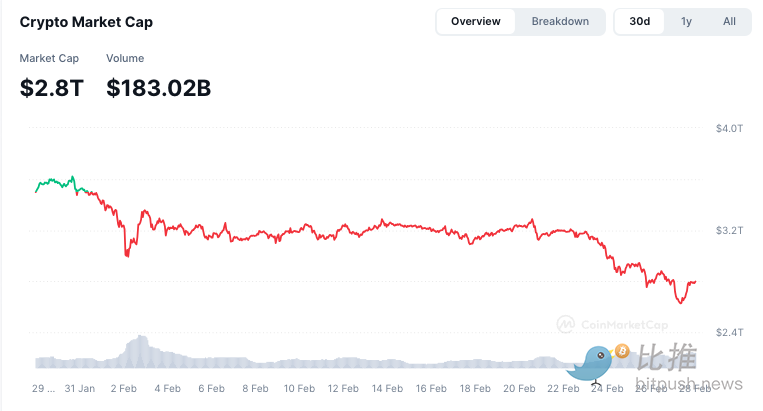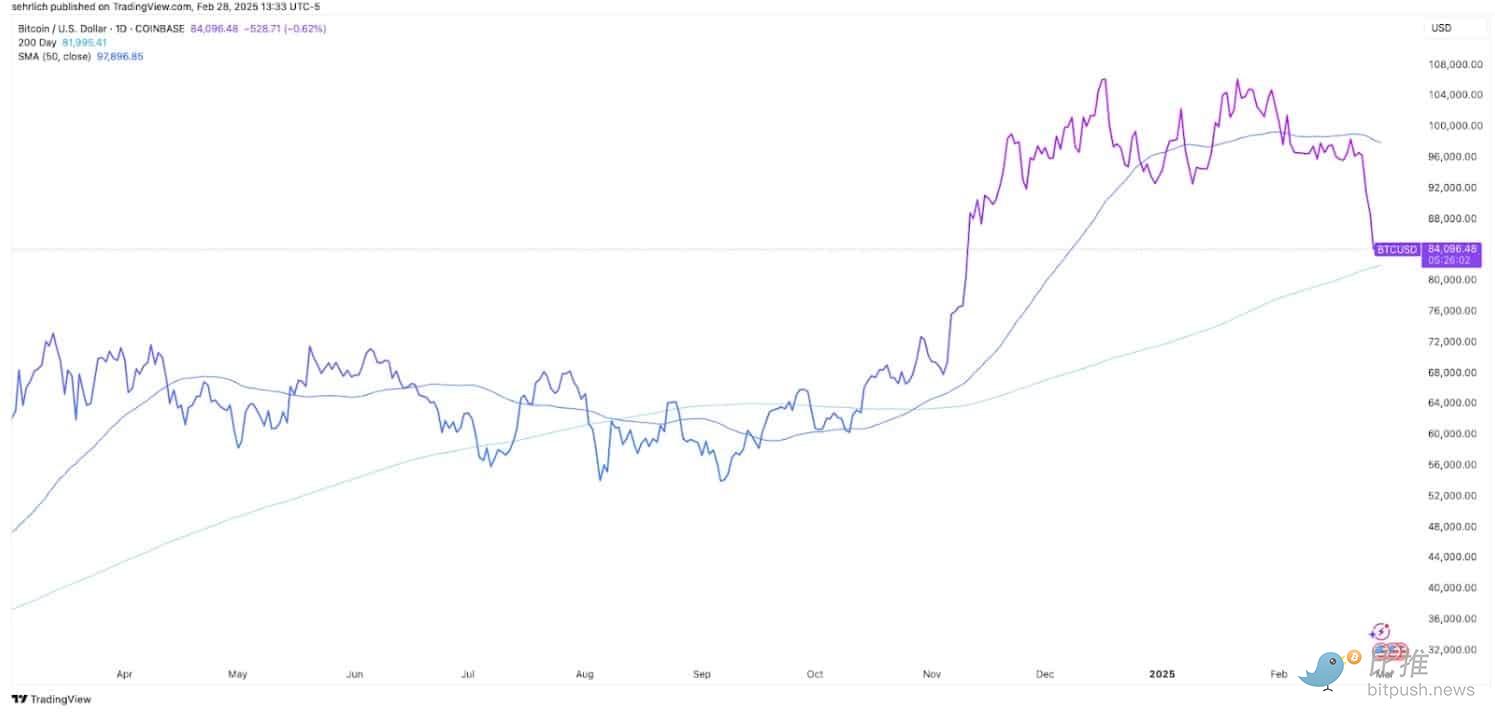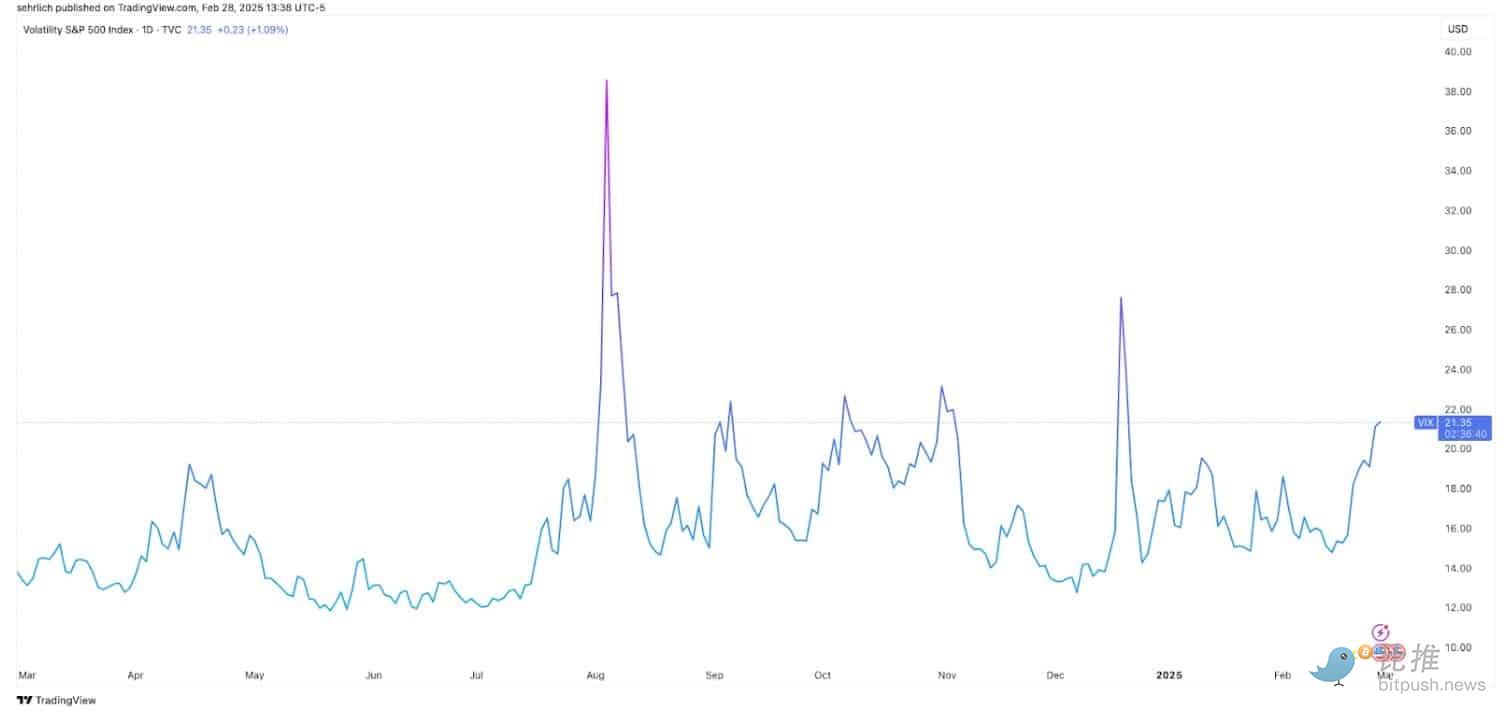Where is the bottom of Bitcoin in this cycle?

Reprinted from panewslab
03/02/2025·2MAuthor: Steven Ehrlich
Compilation and organization: BitpushNew
In 2025, the Trump administration gave a series of "gifts" to the cryptocurrency industry.
The Securities and Exchange Commission (SEC) suspended enforcement actions and investigations into major cryptocurrency exchanges and companies such as Coinbase, Gemini, Uniswap, OpenSea, ConsenSys, etc. The White House issued an executive order aimed at enhancing U.S. leadership in the digital asset industry and expressed its intention to build Bitcoin reserves.
However, none of these moves are enough to stop the recent decline in Bitcoin prices and the overall negative sentiment of the crypto industry. As of writing, the current price of Bitcoin is $84,000, down 18% since Donald Trump’s inauguration, nearly 23% from historic highs, and the total market value of cryptocurrencies has fallen by 21%.

"It feels like all the good news in the cryptocurrency space has happened, and the positive progress in the industry seems to be just because of the whim of senior politicians, lack of due process and due diligence ... situations may change at any time and sustainability is questionable."
Currently, the three major forces driving the market downside may bring it further lower before they can regain their foothold and start to rebound. In fact, the crypto industry may have to wait until 2026 to see the ongoing bull market momentum again.
Internal "backlash"
There are many reasons for explaining the recent decline, first of all, the behavior of cryptocurrency participants themselves.
For example, the industry has been in a disadvantage due to multiple meme farces, such as $MELANIA, and later $LIBRA, which even entangled Argentine President Javier Mile in a scandal. Now, meme coin issuance and trading activity across the industry is declining, which raises questions about its long-term sustainability. For example, the daily issuance of new tokens reached a local peak of 66,471 on January 24, just six days after $TRUMP went live. On February 27, the figure dropped to 27,741, a 58% drop.
Brian Rudick, head of research at GSR, said of the data: "People used to think of meme as the most fair and effective form of speculation in the cryptocurrency space, but $LIBRA shows that it is not the case. Now you're seeing a sharp drop in on-chain transactions, [although] meme coin is the first to take the brunt, but that's dragging the entire cryptocurrency space."
In addition, the $1.5 billion hacking attack by North Korean hackers on Bybit, the largest theft in cryptocurrency history, has once again questioned whether it is safe to put money into cryptocurrency. "These hacking incidents have led to the view that even after 10 years of development, the industry has not yet truly matured," Gupta said.
External headwind
All these negative emotions within the industry are amplified by the wider risk appetite of investors.
Often, the new administration will boost consumer confidence, and business leaders initially welcomed Trump's election because of his pro-business thinking. However, multiple new data show that consumer confidence is weakening, possibly due to Trump's threat of imposing 25% tariffs on trading partners such as China and Canada, Mexico and the EU.
The nonprofit think tank Conference Board's consumer confidence index reported a third consecutive month of decline in February, hitting its lowest level since August 2021.
The University of Michigan Consumer Sentiment Survey also showed that consumer confidence has dropped sharply. "Consumer sentiment continued the downward trend at the beginning of this month, down nearly 10% from January. This decline is common among age, income and wealth groups," the report said.
The report also mentioned: "Expectations for inflation in the coming year rose from 3.3% to 4.3%, the highest level since November 2023, and have seen abnormally significant growth for two consecutive months. The current reading is much higher than the 2.3%-3.0% range in the first two years of the epidemic."
"According to the latest data from the CME Fedwatch tool, the market is expected to cut interest rates twice this year. But if these expectations disappear completely due to tariff issues, the traditional market may fall more than cryptocurrencies," Rudick noted.
How low will Bitcoin fall?
It is difficult to accurately predict how much Bitcoin will fall from now on.
Steve Sosnick, chief strategist at Interactive Brokers, said Bitcoin is unique even in commodities. "You know the supply and demand of crude oil, coffee or cocoa. Bitcoin has no intrinsic demand of the same type. It exists purely for speculative or investment purposes."
However, Sosnick pointed out several technical charts that can provide some ideas for price thresholds that investors should pay attention to.
One of the charts is Bitcoin’s simple 200-day moving average. At current prices, the asset is approaching the first time since a clear breakthrough in mid-October last year. If this happens, which means the asset falls below $80,000, Sosnick believes the next threshold will be the “$60,000 high/$70,000 low range”.

Despite negative investor sentiment, the market has not yet reached a full-scale panic state, according to the S&P 500 Volatility Index (VIX), which is still within the normal range of the past 12 months. "VIX is not at extremely high levels, which means we may not be out of the way because when VIX soars, the rebound tends to stop."

As far as Bitcoin is concerned, this means it may still fall, as investors have not reached the level of extreme panic. For example, when the Bank of Japan raised interest rates and lifted the yen arbitrage trading, the VIX index soared in August; the current VIX index is well below its level at that time.
Waiting for the wind: 2026?
Given that all these negative forces are affecting the price of Bitcoin, it seems that the cryptocurrency industry may need to wait until 2026 for Bitcoin and the industry as a whole to regain substantial momentum forward. When asked what types of internal or external factors may play a role in the process, there are two answers: strategic bitcoin reserves or legislation that sets rules for the industry once and for all.
While the cryptocurrency community has always wanted to build strategic Bitcoin reserves, the White House executive order is designed to assess something different: the Federal Reserve, that the government will choose to hold the Bitcoin it acquires through law enforcement actions, rather than the strategic reserves, that is, the government will buy new Bitcoins. (However, many states are evaluating their own strategic reserves, although few have made meaningful progress.)
Rudick believes something like Bitcoin reserves may be good for the industry, but that's far from a guarantee: "[Reservations] have always been low in my opinion, but I think Bitcoin is easily up to $500,000. Even if we don't get it in the form of strategic Bitcoin reserves, I do think it's possible for the United States to create a sovereign wealth fund and increase Bitcoin."
But for Rudick, a more sustainable path to growth is to create market structure legislation that allows regulated companies to legally enter the field, but he believes the industry will have to wait until next year to make meaningful progress: “[legislation] may not happen until 2026. But in my opinion, the reason this is so important is that it is what institutions need to enter at scale.”
As evidence, he pointed to a recent statement by Bank of America CEO Brian Moynihan, who said his bank, which has a reservation with cryptocurrency, would consider launching stablecoins if the industry’s rules become clearer. (At least one source close to the Washington negotiations believe that stablecoin legislation may even be signed in 2025.)
But until then, the industry needs to remain stable to deal with these disadvantages. After all, this drastic fluctuation in investing in cryptocurrencies is part of the huge risk.
Sosnick summarized the current market situation in one sentence: "The market rise is usually like climbing stairs, and when it falls, it's like taking an elevator. Bitcoin took the elevator to the top floor this time, and now it's taking the elevator to the basement. This is an asset with a lot of volatility. If volatility is good for you, that's good - it's something everyone is happy to accept and enjoy, but when volatility moves in the opposite direction, it's too bad."



 chaincatcher
chaincatcher